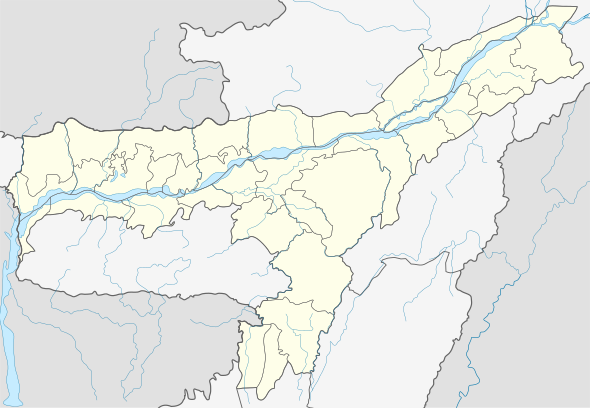Silchar Airport
Silchar Airport (IATA: IXS, ICAO: VEKU) is located at Kumbhirgram, 29 km (18 mi) from Silchar in the state of Assam, India built by the British as RAF Station Kumbhirgram in 1944 and transferred to the Royal Indian Air Force (RIAF). It is also a Civil enclave airport as it is under the control of Indian Air Force. The airport is situated on the foothills of the Barail range. It is the fourth busiest airport of the north-east India next to Guwahati, Agartala and Imphal. Passenger traffic in Silchar airport shoewd a sharp growth of 72.9% in 2017-18, and handled 366,955 passengers. While in 2018-19 the traffic growth was reported 5.4% to 386,665. As of 2018-19 Data available with Airports Authority of India Silchar Airport is 47th busiest airport in India in respect of Passenger Traffic and 49th busiest in respect of Aircraft Movement. Silchar Airport is 43rd busiest in Cargo transportation as of 2017-18.
Silchar Airport | |||||||||||
|---|---|---|---|---|---|---|---|---|---|---|---|
| Summary | |||||||||||
| Airport type | Civil Enclave | ||||||||||
| Owner | Indian Air Force | ||||||||||
| Operator | Indian Air Force, Airports Authority of India | ||||||||||
| Serves | Cachar District, Hailakandi District, Karimganj District and parts of Mizoram, Manipur, Meghalaya and Tripura. | ||||||||||
| Location | Kumbhirgram, Silchar, Assam, India | ||||||||||
| Elevation AMSL | 352 ft / 107 m | ||||||||||
| Coordinates | 24°54′47″N 092°58′43″E | ||||||||||
| Map | |||||||||||
 IXS Location of airport in Assam  IXS IXS (India) | |||||||||||
| Runways | |||||||||||
| |||||||||||
| Statistics (April 2017 - March 2018) | |||||||||||
| |||||||||||
Source: Airports Authority of India[4]
Infrastructure
The Silchar airport terminal, handling domestic flights, it can handle aircraft such as Boeing 737-800 and Airbus A320. Amenities include a restaurant, a handicrafts shop, ATMs, chocolates shop, and free WiFi.
There is a single asphalt runway with dimensions (7500 ft / 2286m) .
Lighting System: PAPI - Precision Approach Path Indicator visual aid for both side of the runway (06/24) that enables pilots to maintain the correct approach (in the vertical plane) towards the airport and ILS - Instrument landing system provides a direction for approaching when the aircraft tune its receiver to the ILS frequency, it provides both lateral and a vertical signals. Glide slope station which is an antenna array sited to one side of the runway touchdown zone is also available towards runway (06/24).
Facilities
Silchar airport is situated at an elevation of 338 feet above the sea level. It covers the land area of 36.70 acres. There is only one domestic terminal. The terminal has four check-in counters along with one boarding gate to handle nearly 300 passengers at a given time with 150 each at the arrival and the departure section. Rest rooms are also available for transit passengers with charges applied as per AAI rules. There are two conveyor belts available in the arrival building to support multiple aircraft at a single time. Indian Oil handles the Aviation fuel service department of Silchar Airport. Silchar airport has a variety of options for eating and shopping at the airport premises. Moreover, shops selling local handicraft items are also there at the airport. The airport comes under the administrative control of the Airports Authority of India. The guidelines prescribed by the Airports Authority of India are adhered to while carrying out the daily operations of Silchar Airport.
Airlines and destinations
| Airlines | Destinations | Refs. |
|---|---|---|
| Air India | Kolkata | [5] |
| IndiGo | Bengaluru, Guwahati, Hyderabad, Kolkata, Mumbai | [6] |
| SpiceJet | Delhi, Guwahati, Kolkata | [7] |
Transportation to Airport
The Assam State Transport Corporation (ASTC) operates the Volvo air-conditioned bus services to Silchar airport from Rangirkhari Point and the Inter-State Bus Terminus (ISBT). From the ISBT one can find buses to other cities of the north-eastern region.
Besides Taxis are also available to and from the Airport to city, Hailakandi & Karimganj.
References
- "Traffic News for the month of March 2018: Annexure-III" (PDF). Airports Authority of India. 1 May 2018. p. 3. Retrieved 1 May 2018.
- "Traffic News for the month of March 2018: Annexure-II" (PDF). Airports Authority of India. 1 May 2018. p. 3. Retrieved 1 May 2018.
- "Traffic News for the month of March 2018: Annexure-IV" (PDF). Airports Authority of India. 1 May 2018. p. 3. Retrieved 1 May 2018.
- "Traffic News for the month of March 2018: Annexure-IV" (PDF). Airports Authority of India. pp. 3–4. Archived (PDF) from the original on 1 May 2018. Retrieved 1 May 2018.
- "Air India timetable". Air India. Retrieved 8 November 2018.
- "Flight Schedule for Domestic & International Flights". IndiGo. Retrieved 25 December 2018.
- "SpiceJet flight schedule". SpiceJet. Retrieved 12 January 2020.
External links
| Wikimedia Commons has media related to Silchar Airport. |
- Airport information for VEKU at World Aero Data. Data current as of October 2006.